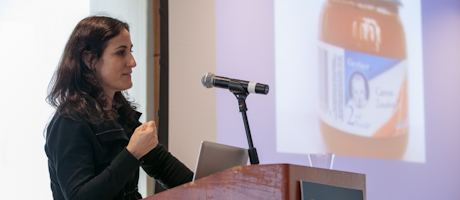When Amy Bentley’s son was old enough for solid foods, she headed into the uncharted territory of her grocer’s baby food aisle. Eyeing the ingredients on a cute little jar of applesauce, she read: apples, water and vitamin C. Oddly similar to the ingredients on a jar of grown-up applesauce, she thought.
That’s when she realized, she said: “We have commoditized this product, and kind of invented it—this idea of baby food. It really struck me as so interesting and has become such a rite of passage and such a part of mainstream American culture.”
It set Dr. Bentley, an associate professor of food studies at New York University, off on a 17-yearlong project investigating why baby food was even developed and, more importantly, how it shapes taste from a very early age. On Monday, she shared her research in the presentation, “Baby Food and the Industrialization of Taste in the United States” to kick off this semester’s George Washington University Seminar on Food events surrounding the theme of appetite.
Baby food wasn’t always the robust industry it is today, and many factors contributed to its rising popularity in the post-war United States during the ’50s and ’60s, Dr. Bentley said. Principal among them were the industrialization of the food supply, the discovery of vitamins and their importance and changing philosophies on child-rearing that de-emphasized breastfeeding. An advertising blitz—Dr. Bentley flashed images of ads with small babies and lines like “the tiniest babies enjoy Gerber’s bananas”—also fueled the rise.
So many mothers during this time began introducing solids at an early 4 to 6 weeks. (The American Academy of Pediatrics currently recommends introducing solids after 6 months, but notes it should only supplement breastfeeding until at least 12 months.) “Infants, days after birth, were being fed these types of foods that only create a pathway to being receptive to the industrial diet,” Dr. Bentley said.
Around the same time, many supermarkets began catering to new mothers with long aisles and big pyramids of baby food prominently displayed to capitalize on a segment of the public considered most valuable to their bottom lines. Baby food and evaporated milk (which is used in formula) were the top-selling items. Breastfeeding rates were low. And what was even more troubling was that many jars of baby food weren’t even very healthy, Dr. Bentley said. A jar of carrots during the time, for instance, contained light brown sugar, sugar, butter and salt.
But then came the ’70s, and with all the changes brought in the countercultural movement, mothers began reconsidering the mass-produced baby food.
“All of a sudden, people kind of sit up and begin to think about food in this critical way,” Dr. Bentley said. “And think about baby food, and the feeding of infants, in this critical way.”
Studies were published showing potentially harmful effects of food additives found in some baby food, and researchers questioned whether babies’ bodies could tolerate the super-early introduction of solid foods. The benefits of breastfeeding were also reaffirmed. When mothers did switch their children to solid foods, many found do-it-yourself solutions and make their own pureed carrots or apples without added ingredients.
Today, parents’ food choices for their children vary widely, and many approaches are considered perfectly healthy. In Dr. Bentley’s opinion, though, one thing is certain: “The early introduction of baby food primes that industrial palate.”
The University Seminar on Food will host two more events in the coming weeks. On April 19, Dartmouth College Associate Professor of Geography Susanne Freidberg will present “The Unnatural History of Freshness.” On April 30, Sylvie Durmelat, associate professor of French and Francophone studies at Georgetown University, will present “Reel Couscous: The Migrant’s Table on Screen in Maghrebi-French Cinema.”


